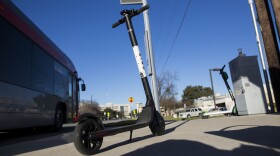If you've ever been aggravated by a scooter blocking a sidewalk, taking up a prime parking spot or just making it difficult to maneuver around town, you might find some joy in the fact that soon there will not be as many of them.
Electric scooters, or e-scooters, have become a popular mode of transportation, especially for people traveling short distances, but they’ve created concerns around safety and accessibility.
Walking downtown or anywhere with a cluster of businesses, restaurants and other places of entertainment means an e-scooter is often nearby. They're sometimes found lying on their side and blocking sidewalks. Some have even been dumped in Lady Bird Lake and ditches.
But new rules implemented on Monday mean Austin will have fewer scooters and a few more rules to address these issues.
Richard Mendoza, director for Austin’s Transportation Department, said his team worked with vendors to reduce the number of devices around town and create designated staging areas.
“We have arrived at a place where we can provide and assure quality services, address the safety concerns, and address the just general overall proliferation and concentration and clustering of these devices throughout this city,” he said.
Reducing the fleet
Originally, Mendoza said, the city had three vendors — Bird, Lime and Link — in Austin. The city permitted more than 14,000 scooters between the vendors, with up to 5,000 allowed downtown.
“That presented a challenge for our department to effectively manage that amount of devices,” he said.
Today, that number is down by more than half.
The city now has about 6,700 e-scooters, with about 2,250 in the downtown area, Mendoza said.
At the end of last year, Link ceased operations in North America leaving Austin with just Lime and Bird. Mendoza said that gave the city a chance to evaluate how well two vendors could do in the city and the demand was still met. He said the reduction has been helpful for management and still serves the users' needs.
“We will continue to monitor going forward — every six months — on the number of permitted devices along with flexible understanding that large events like South by Southwest and ACL drive up the demand for these devices,” Mendoza said. “We will make special allowances to provide those.”
Addressing safety and accessibility
Mendoza said part of addressing the challenges with scooters is also about speed and assigning designated areas for the devices once a trip is complete.
Reducing the maximum speed during late night hours will be part of a pilot program the city is testing.
“Another issue that we struggled to address were reports of serious head injuries, and many of these are occurring in the late night hours after people leave the bars,” he said
Mendoza said the city now requires the scooter companies to drop speeds from 15 mph to 10 mph between 10 p.m. and 5 a.m. in the main entertainment district downtown. He said the city will evaluate the results after three months to determine if any changes need to be made.
To help with the overabundance of scooters in one area and the blocking of sidewalks and other ADA walkways, Mendoza said, the city is assigning designated parking areas for scooters. It will also require companies to rebalance the scooters so they stand up.
New signage with proper parking info will go up over the next several months and is anticipated to be complete by the end of the summer.





